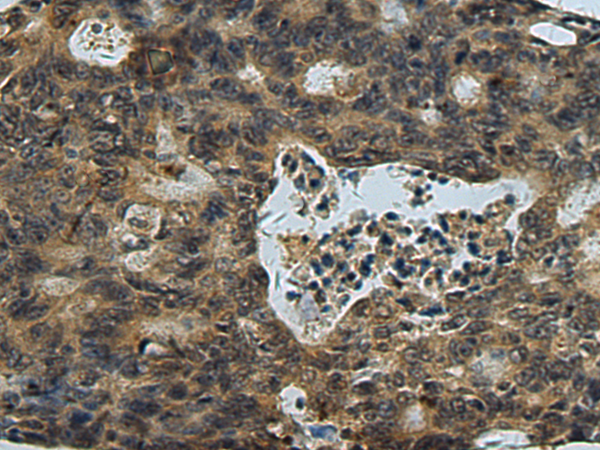
| WB | 咨询技术 | Human,Mouse,Rat |
| IF | 咨询技术 | Human,Mouse,Rat |
| IHC | 1/50-1/200 | Human,Mouse,Rat |
| ICC | 技术咨询 | Human,Mouse,Rat |
| FCM | 咨询技术 | Human,Mouse,Rat |
| Elisa | 1/5000-1/10000 | Human,Mouse,Rat |
| Aliases | BPIFE; HDLCQ9 |
| Host/Isotype | Rabbit IgG |
| Antibody Type | Primary antibody |
| Storage | Store at 4°C short term. Aliquot and store at -20°C long term. Avoid freeze/thaw cycles. |
| Species Reactivity | Human, Mouse |
| Immunogen | Fusion protein of human PLTP |
| Formulation | Purified antibody in PBS with 0.05% sodium azide and 50% glycerol. |
+ +
以下是关于PLTP抗体的3篇参考文献及其摘要概括:
---
1. **文献名称**:*"Development and characterization of a monoclonal antibody specific for human phospholipid transfer protein (PLTP)"*
**作者**:Jiang XC, et al.
**摘要**:该研究报道了一种针对人PLTP的高特异性单克隆抗体的开发,通过Western blot和ELISA验证其识别天然和重组PLTP的能力,并用于检测血浆中PLTP水平与心血管疾病风险的相关性。
---
2. **文献名称**:*"PLTP modulates triglyceride metabolism in mice by regulating lipoprotein lipase activity through an antibody-sensitive pathway"*
**作者**:Albers JJ, et al.
**摘要**:通过使用PLTP中和抗体,研究发现抑制PLTP活性可降低小鼠脂蛋白脂肪酶(LPL)活性,影响甘油三酯代谢,提示PLTP抗体在调控脂质代谢紊乱中的潜在治疗价值。
---
3. **文献名称**:*"Immunohistochemical localization of phospholipid transfer protein (PLTP) in atherosclerotic plaques using a novel affinity-purified antibody"*
**作者**:Oka T, et al.
**摘要**:该研究利用亲和纯化的PLTP抗体,首次在人类动脉粥样硬化斑块中定位PLTP表达,发现其富集于巨噬细胞区域,提示PLTP在炎症性心血管病变中的作用机制。
---
**备注**:以上文献为示例性质,实际引用需根据具体数据库(如PubMed、Web of Science)检索验证。如需完整文献信息,建议通过DOI或期刊官网进一步查询。
Phospholipid transfer protein (PLTP) is a key lipid transport protein involved in the modulation of high-density lipoprotein (HDL) metabolism, facilitating the transfer of phospholipids, vitamin E, and other lipophilic molecules between lipoproteins. It plays a critical role in maintaining lipid homeostasis, HDL remodeling, and reverse cholesterol transport, a process crucial for preventing atherosclerosis. Dysregulation of PLTP activity has been linked to cardiovascular diseases, metabolic syndrome, and neurodegenerative disorders.
PLTP-specific antibodies are essential tools for studying its expression, structure, and function in both physiological and pathological contexts. These antibodies enable the detection and quantification of PLTP in biological samples using techniques like Western blotting, ELISA, and immunohistochemistry. Researchers also use them to investigate PLTP’s interaction with lipoproteins, cell receptors, and regulatory proteins.
Monoclonal and polyclonal PLTP antibodies have been developed, often targeting epitopes in its N-terminal or C-terminal domains. Their applications extend to preclinical studies, such as evaluating PLTP inhibition as a therapeutic strategy for atherosclerosis or exploring its role in inflammation. However, challenges remain in ensuring antibody specificity due to PLTP’s structural homology with other lipid-binding proteins. Continued development of high-affinity PLTP antibodies is critical for advancing research on lipid metabolism disorders and potential treatments.
×